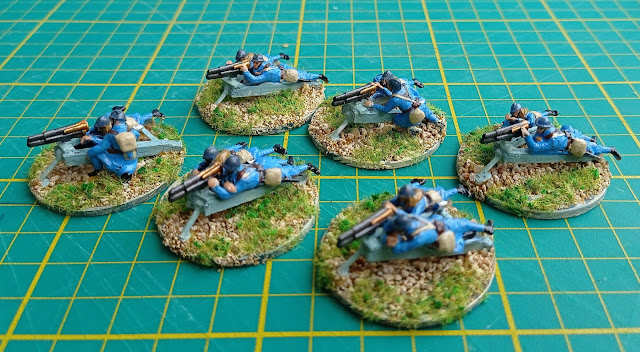Many years ago I built a number of armies for WW1. They were painted in a simple block painting and glued to some fragile 6cmX2cm rectangles. Recently I started to change the basing to GWSH style and trying to have a full corps of every main belligerent of this conflict. For that I´m in the process of adding a number of stands to each miniature army and thus returning to the block painting style to go along with the many miniatures painted in the past. On the down side they don´t become so flashy but on the other hand you speed up painting really quick which is particularly helpful when you need many hundred figures.
After doing this to the Germans, which you can see in the two previous videos on this blog (or on the You Tube to be able to see it bigger), I went to the French. The rifle companies of the six regiments made up to the moment are not shown as they are simple Revell, Airfix and Pegasus figures with nothing special to say about them, instead you can see here a number of conversions that I hope can be useful to anyone modelling French WW1 in 20mm. For the full French corps there is a another video being prepared were you can see everything altogether.
The group already converted and ready to be painted. Everything was primed with PVA glue.
For each infantry regiment you need a 37mm TIR gun. These guns were used to take away MG nests and the sort and there was also a wheeled version. The gun tube comes from the HAT US WW1 box and needs a proper support as the one offered in the box suits only the Hotchkiss 8mm MG (there are a total of four different guns per sprue but only one type of support). With some styrene you can have a simple and effective support as shown in this picture. Don´t bother too much with detail as the figures lying on top of the support will hide most of it.
I used conversions of the relatively useless Revell laying down figures shooting the Lebel rifle for artillery men together with some Pegasus extras and even some old rifleman from Airfix with new arms.
The painted lot, one 37mm TIR for each infantry regiment. If you don`t want to bother making these gun conversions you can use the StreletsR Colonial Foreign Legion ones which, for obvious reasons, are not very easy to find today.
The corps needs a total of 18 (or 24 if you want divisons with four regiments) Hotchkiss 8mm HMGs. The majority are Revell which have two per box but after using plenty of them for WW2 I had to made up the last five. I used HAT MGs from the US WW1 and the WW2 Foreign Legion boxes with converted firers from the wounded Airfix WW1 British (with GreenStuff arms) and Chauchat firers from Revell.
The laying down Revell figures are also useful top make binoculars observers and loaders after cutting the rifle and applying some heat to the arms.
The French used a number of different trench mortars including the British Stokes but I wanted something different as these 86mm Boileau- Debladis compressed air mortars. I used the Newton 6 inch included in the HAT US WW1 box as a start and added a number of plastic parts to make it reasonably close to the Boileau-Debladis mortar. The compressed air container is made from a WW2 or modern aircraft bomb.
No, the mortar bombs are not Italian but just the colors I found in the web for these, even if not 100% sure about that. The figures are from the WW2 French artillery set by HAT.
A picture of the real thing for extra detail.
To the left you see the Corps command stand and to the right the 2nd division command stand.
The radios are made from pieces of styrene and the radiomen are Airfix figures with new GreenStuff arms and are intended to portray some rough examples of the TSF posts.
The officer figures comes from the HAT WW2 French artillery, WW2 Pegasus and WW1 Revell sets.
All my HAT WW1 cavalrymen were sucked into the 5e DLC for 1940 so I had to improvise for the six stands of cavalry necessary for the infantry corps. The horsemen of the HAT WW2 French artillery were used for the effect with lances made out of broom sticks. The horses are Napoleonic Italeri with some GreenStuff extras used to conceal the pistols.
The cavalry rifles came from a number of WW2 plastic sets and need to be on the back of the cavalrymen.
The figures were also helpful as the right arm can help to hold the lance with the help of a piece of leather as originally.





















Always interesting to see your conversions and they look good with their block painting.
ReplyDeleteThanks Peter. Seen from 1 meter away there isnt much Difference.
DeleteAs always wonderful work on those conversions and scratch built items JP!
ReplyDeleteThanks Steve. Its my way to have the best fun with the hobby. And keep it more or less cheap:)
ReplyDeleteWow you did some great conversions!
ReplyDeleteThanks Uve.
Delete